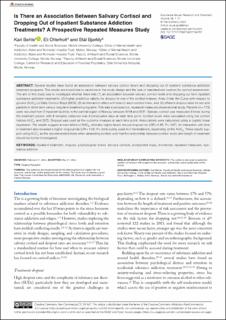| dc.contributor.author | Bøhle, Kari | |
| dc.contributor.author | Otterholt, Eli | |
| dc.contributor.author | Bjørkly, Stål | |
| dc.date.accessioned | 2024-03-15T13:21:01Z | |
| dc.date.available | 2024-03-15T13:21:01Z | |
| dc.date.created | 2022-07-11T11:34:11Z | |
| dc.date.issued | 2022 | |
| dc.identifier.citation | Substance Abuse: Research and Treatment. 2022, 16, 1-11. | en_US |
| dc.identifier.issn | 1178-2218 | |
| dc.identifier.uri | https://hdl.handle.net/11250/3122690 | |
| dc.description.abstract | Several studies have found an association between salivary cortisol levels and dropping out of inpatient substance addiction treatment programs. The results are mixed due to variations in the study design and the lack of standardized routines for cortisol assessment. The aim of this study was to investigate whether there was (1) an association between salivary cortisol levels and dropping out from inpatient substance addiction treatments; (2) higher predictive validity for dropout in one of the cortisol indexes: Area Under the Curve with respect to ground (AUCG) or Daily Cortisol Slope (DCS); (3) an interaction effect with time for each cortisol index; and (4) different dropout rates for sex and patients in short-term versus long-term treatment programs. This was a prospective, repeated-measures observational study. Patients (n = 173) were recruited from 2 inpatient facilities in the central region of Norway between 2018 and 2021. Salivary cortisol was measured 4 times during the treatment period, with 8 samples collected over 2 consecutive days at each time point. Cortisol levels were calculated using the cortisol indices AUCG and DCS. Dropout was used as the outcome measure at each time point. Associations were calculated using a logistic linear regression. The results suggest a main effect of AUCG, whereby higher levels reduce dropout risk (OR = 0.92, P = .047). An interaction with time in treatment also revealed a higher dropout risk (OR = 1.09, P = .044) during week 4 of the treatment, depending on the AUCG. These results support using AUCG as the recommended index when assessing cortisol, and that the relationship between cortisol levels and length of treatment should be further investigated. Keywords: inpatient treatment, dropout, physiological stress, salivary cortisol, prospective study, biomarker, repeated measures, substance addition | en_US |
| dc.language.iso | eng | en_US |
| dc.relation.uri | https://journals.sagepub.com/doi/10.1177/11782218221106797 | |
| dc.rights | Navngivelse-Ikkekommersiell 4.0 Internasjonal | * |
| dc.rights.uri | http://creativecommons.org/licenses/by-nc/4.0/deed.no | * |
| dc.title | Is there an association between salivary cortisol and dropping out of inpatient substance addiction treatments? : a prospective repeated measures study | en_US |
| dc.type | Peer reviewed | en_US |
| dc.type | Journal article | en_US |
| dc.description.version | publishedVersion | en_US |
| dc.source.pagenumber | 1-11 | en_US |
| dc.source.volume | 16 | en_US |
| dc.source.journal | Substance Abuse: Research and Treatment | en_US |
| dc.identifier.doi | 10.1177/11782218221106797 | |
| dc.identifier.cristin | 2037928 | |
| cristin.ispublished | true | |
| cristin.fulltext | original | |
| cristin.qualitycode | 1 | |

